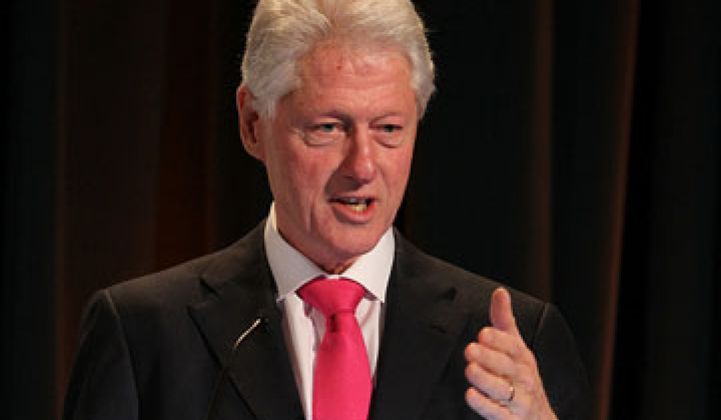Earlier this month, Mirebalais Hospital in Haiti starting installing 1,800 solar panels. The hospital, run by nonprofit Partners in Health, will have the largest solar array in Haiti and expects the panels to pay for themselves in less than three years.
“The Caribbean has some of the highest electricity rates in the world,” Bill Clinton said at the Sustainable Operations Summit in New York last Thursday. “Almost every country in the Caribbean could be completely energy independent with solar, wind, geothermal and biomass.”
The problem, obviously, is the high upfront cost of renewables and the fact that some of the poorest countries, like Haiti, don’t have the systems in place to allow for investment in renewables and energy efficiency.
But that’s changing, if the Clinton Foundation’s Climate Initiative has anything to do with it. These days, he’s traveling the globe touting the value of energy efficiency upgrades as a local job creator and the need to bring renewables to regions of the world that need them the most. “It’s extremely frustrating to see how long it’s taking,” he said in regards to creative energy efficiency financing models.
The time for solutions, like rethinking on-bill financing, is now. Clinton noted that the Empire State Building, which has undergone one of the most widely cited retrofits, is not necessarily replicable. Although the project, led by Tony Malkin, whose company owns the Empire State Building, has been extremely transparent, there was the money upfront to pay for some of the substantial retrofits, including upgrading many of the landmark’s custom windows to be more efficient.
Money like that just isn’t available in most buildings, and certainly not in Haiti, where solar projects have largely been financed by donations, such as in the case of the hospital, which had various donors, including NRG Energy.
But that is changing. Ensera, a Haitian company, designs and manufactures solar panels and appliances, including mobile phone chargers, solar streetlights and solar lamps. Other groups, like SharedSolar, which builds microgrid projects that could be deployed in Haiti soon, are proliferating as well.
The key to financing sustainability, whether it’s retrofitting existing building stock in first-world countries or building renewables in third-world countries, is creative financing, according to Clinton.
Because retrofits like the Empire State Building could be difficult to replicate, “the next best thing is on-bill financing,” said Clinton. “We have to get it to a ‘just say yes’ system.”
California is working on a new on-bill financing scheme that would allow for banks to underwrite the loans that go out through utilities. The problem with most existing programs is that utilities do the underwriting. “It’s always better to use other people’s money,” said Brad Copithorne, energy and financial policy specialist for the Environmental Defense Fund, which has been working on designing California’s proposed on-bill financing program. By minimizing the role of the utility, it could reduce the cost and build far larger funds to finance distributed generation and energy efficiency.
“When you think about all of the capital that wants to get into this space and all the labor that’s available, I feel like its 1994 with the web: it hasn’t quite tipped yet, but in two or three years, the dam will break,” Murat Armbruster, senior advisor to the Carbon War Room, said at the Sustainable Operations Summit.
Breaking the dam will require user-friendly solutions, according to Clinton. Entities will have to be willing to bear the cost completely upfront for energy efficiency upgrades and distributed renewables to become commonplace. “We have to keep proving this is good economics,” said Clinton. “This is a place where people can get a return.”
Clinton pointed to city programs in Chicago, New York and Houston that encourage energy efficiency through initiatives like infrastructure trusts, energy benchmarking mandates and aggressive building standards. But these few initiatives are not enough, according to Clinton. Only partially kidding, he said that Exxon Mobil should have a building retrofit division “because they can get whatever they want from Congress.”
The few visible success stories, like solar panels on the new hospital in Haiti run by Partners in Health or the very successful retrofit of the Empire State Building, must be easily replicable for rich and poor countries to move to cleaner energy economies. “You can’t get there by telling cute stories about how innovative Tony Malkin is,” said Clinton, referring to the owner of the Empire State Building. “We have to show in the energy debate where we can create markets through alternative financing mechanisms.”
Stay tuned, because Clinton is just getting started on this topic.



